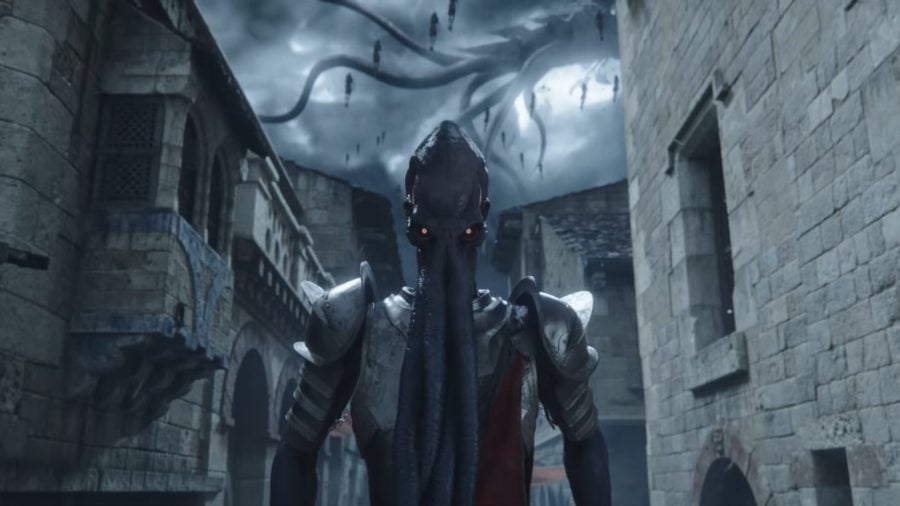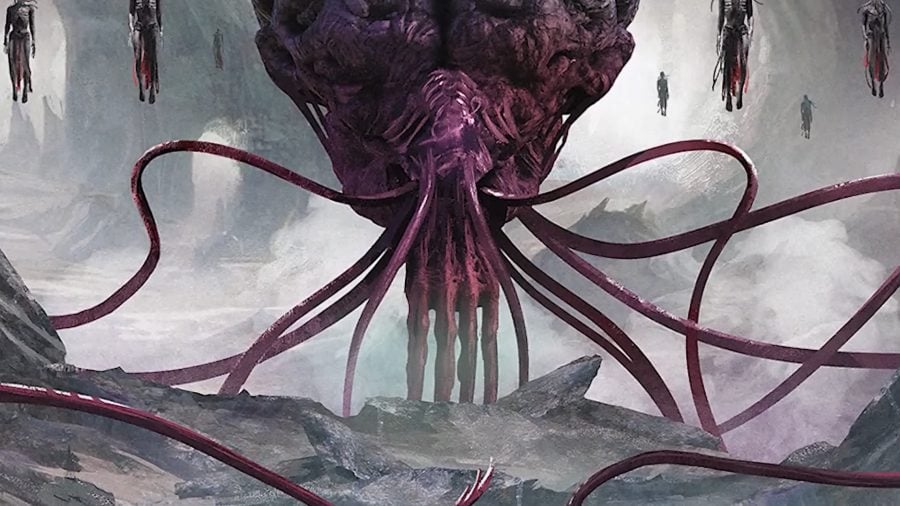Tentacled, telepathic, and fixated on guzzling down some tasty, tasty brains, mind flayers are one of the most well known monsters in all of Dungeons and Dragons. Far more unusual than many of the critters you’ll encounter in your Monster Manual, they battle it out with their aberrant cousins, the Beholders, for the prestigious title of most iconic unique D&D monster.
While they’ve been around since the earliest iterations of D&D, in recent years, mind flayers or illithids seem to have reached new heights of popularity, giving their name to the strange hivemind creature in Stranger Things seasons 2 and 3, and taking on the role of primary antagonists in the D&D game Baldur’s Gate 3. There’s something particularly horrible about this intelligent monster that seems to fascinate. An owlbear will eat you, big whoop. A dragon will toast you, oh dear. A mind flayer will take over your mind, turn you into its thrall, and then devour your brain… Ew.
If you want to learn more about the mind flayer 5e, you’ve come to the right place. We’ll fill you in on this creature’s biology, habits, powers, and stats. Read on… if you dare!

What is a 5e Mind flayer?
Mind flayers, otherwise known as illithids, are humanoid creatures with octopus heads. They are alien creatures, who once controlled vast empires, spanning dimensions. But these collapsed long ago, and the mind flayers who remain on the Material Plane live in the Underdark, in different groups each controlled by an Elder Brain.
Mind Flayers have psychic or psionic powers that they use to dominate their foes, which pretty much includes every humanoid that’s not another mind flayer – illithids are keen on world domination, and restoring their lost empires. Their diet includes the brains of other intelligent lifeforms, which puts them at odds with virtually everyone.
Get me out of here: The best D&D settings
Mind flayers have bizarre, and quite unpleasant life cycles. They start out as little tadpoles, swimming around in the paddling pool that houses their Elder Brain (literally a giant brain, one controls each mind flayer society, and they’re made out of dead illithids). Most of these mind flayer tadpoles are eaten by the Elder Brain, but the ones that survive to maturity are then implanted in a humanoid by an illithid. Over the course of one week, the budding mind flayer will consume its host’s brain, and replace it, turning the poor creature into an illithid. Oh, and when the mind flayer dies, its brain is returned to to Elder Brain pool and devoured. Waste not, want not!
Though admittedly quite awful, mind flayers have a lot of interesting parallels with some of the more disturbing parasitic creatures on earth. Take parasitic wasps, for instance, who lay eggs in live caterpillars so their young can devour them from within. Or consider creatures like flukes, parasitic worms that take over the minds of insects and try to get them eaten so they can move on to the next stage in their life cycle (which relies on being inside a cow, or a bird, or something).

Mind Flayer 5e Stats
Here are the basic mind flayer 5e stats you’ll find inside the standard Monster Manual. If you want to bump up the challenge level, you could consider using the mind flayer arcanist – basically the same creature, but with the kind of D&D spells a Wizard could learn. Volo’s Guide to Monsters also has a similarly tough mind flayer psion – an illithid who’s taken its study of psionics further than most.
Alternatively, if you want a slightly weaker mind flayer, Ravenloft has vampiric mind flayers, which are a bit feebler than the regular kind. And as always, don’t be afraid to homebrew up your own monsters, if none of these are your cup of tea.
Here are the stats of your typical 5e mind flayer:
| Challenge Rating | 7 |
| Proficiency Bonus | +3 |
| Armour Class | 15 (breastplate) |
| Hit Points | 71 (13d8 + 13) |
| Speed | 30ft |
| Strength | 11 (+0) |
| Dexterity | 12 (+1) |
| Constitution | 12 (+1) |
| Intelligence | 19 (+4) |
| Wisdom | 17 (+3) |
| Charisma | 17 (+3) |
| Saving Throws | Int +7, Wis +6, Cha +6 |
| Skills | Arcana +7, Deception +6, Insight +6, Perception +6, Persuasion +6, Stealth +4 |
| Senses | Darkvision 120 ft, Passive Perception 16 |
| Languages | Deep Speech, Telepathy 120 ft, Undercommon |
| Abilities | Magic Resistance, Innate Spellcasting (Psionics) |
| Actions | Tentacles, Extract Brain, Mind Blast |

Mind Flayer 5e attacks
The attacks of the mind flayer are all geared towards incapacitating and grappling a player, and then extracting its brain. Which, if you didn’t guess, will probably kill you. Instantly. So it’s probably best not to let that happen.
In 5e, illithids can attack with a Mind Blast attack in a 60ft cone which, on a failed DC 15 Intelligence save, deals 4d8+4 psychic damage and stuns targets for a minute. This ability recharges on a 5 or 6, so it thankfully can’t be spammed.
They can also hit you with their tentacles, which do 2d10+4 damage. More importantly, this attack grapples targets who are of medium size or smaller, and stuns you if you fail that same DC 15 saving throw.
Once an illithid has a target stunned and grappled, it can then use Extract Brain to deal a whopping 10d10 piercing damage. If that reduces your health to zero, you are D-E-A-D. If it doesn’t, I guess your brain got taken out, but it was only a minor inconvenience for someone as mighty as you?
Backing up its regular attacks is the mind flayers innate spellcasting. It can use the spells Detect Thoughts and Levitate at will, which perhaps aren’t that useful in combat, but are worth being aware of. More importantly, once per day an illithid can use Dominate Monster and Plane Shift, two truly nasty spells. In combat, a mind flayer may try to take control of your strongest party member, or banish them to some far-off plane, never to be seen again.
Source: Wargamer




